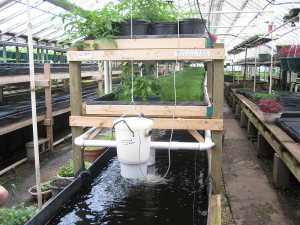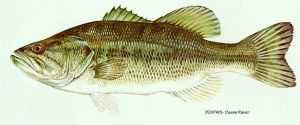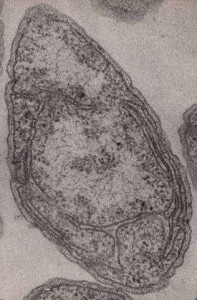
About once a month I paid a visit to a couple that live about twenty minutes from me. One day they discussed with me their new found interest in aquaponics.1
I received a royal tour of the greenhouse, which holds a basin for fish, pumps, tubs, tubing, gravel beds, and filters. I was favorably impressed!
One Man’s Poison
Fish produce body wastes. The word wastes in this instance can be changed to treasure, as the fish wastes serve as food for the plants. The waste water is pumped through plastic piping above tubs of pea gravel, in which the plants are rooted, free of soil.
The piping has small holes. This sprinkles the plants with the nutrient-containing water. The plants, even when small, yield an amazing crop. The couple’s bell pepper plants, though less than a foot tall, carried full-size fruits!

Plum Buggy
Usually plants do not prosper in fish waste; however, bacteria can and does alter that. The ammonia (NH₃), from the fish, is changed by nitrosomonas bacteria into nitrites (NO₂ˉ). Now nitrites in as such are not beneficial to plant or fish! However, Nitrospira bacteria take it a step further, oxidizing nitrites into nitrates (NO₃ˉ).

This is just what the plants need, nitrates. Some suggest that in addition seaweed extract should occasionally be added. Others suggest trace metals, such as iron. Mineral supplements are available, but may not be necessary, especially after the first year of operation.
2 is Better Than 1 – Aquaponics
What are some of the benefits of aquaponics? The water the fish are in does not need frequent change; only a little needs to be replaced because of evaporation. The water the plants receive is not contaminated by fertilizers or herbicides. No weeds can grow where there is no soil! The fresh-water tilapia fish prosper under conditions most fish do not well tolerate. In terms of maximum efficiency and minimum pollution, raising fish and plants together can’t be beat.
Note: You might also enjoy Is Fish Really Brain Food?
Resources:

Hi Vince! As someone who keeps and breeds tropical fish I am aware of the relationship between fish and aquatic plants (and indeed the interconnection of all living things). Some of my aquarist friends do something very similar to what is described in this article, not for the purpose of growing food plants or fish, but for the reasons of recreating as natural as environment as possible – one in which the fish will be happier and more content and therefore more likely to reproduce. The major drawback this has in terms of keeping and breeding ornamental fish is that stocking levels are low because of the confining nature of home-based aquaria (my average tank size is 24 x 12 x 12 inches). You also refer to the nitrogen cycle and indeed plants do need nitrates, but fish don’t! Many of the rarer and more sought-after ornamental species for home aquaria are very sensitive to nitrates and can’t tolerate levels which rise above single figures and such low levels of nitrates are very hard to maintain in small aquaria without artificial filtration which goes against the principles of the ”natural” maintenance of aquaria. There is one very common, easily kept and fairly easily bred fish which will beat even tilapia for tolerating high nitrate levels – the humble goldfish! Goldfish have been successfully kept in conditions where the nitrate levels are in the hundreds of ppm and they can tolerate levels in the thousands for short periods, levels which would kill many nitrate-sensitive fish in a matter of hours. Interesting article!
Very interesting indeed. Of course I don’t want to eat goldfish, but your discussion is enlightening. I once had a half-dozen or so tanks, the largest of which was a 55-gallon tank. If there’s one thing I’ve learned is avoid artificial light in tanks. It lessens lifespan. Fish generally hide from excess light. We had blue tetras that lived 2x a “normal” lifespan in captivity. The only real difference was I used no lights.
What I and fellow club members (and probably every other serious aquarist in the world) has found is that the spectrum of any light supplied to an aquarium can greatly affect plants. Fish don’t seem to mind varying light levels nor what the light source is but many plants need not only the proper type of light (spectrum-wise) but appropriate levels of intensity and duration in order to thrive. Plant needs vary greatly – almost as much as the needs of difference species of fish and getting the mix right can be problematical (this will also be true of aquaponics). There are some aquarists I know who simply can’t get the balance right and have foregone growing plants at all in preference to raising fish in bare tanks for breeding and showing purposes. I have never been a follower of this method, believing that a holistic approach is both better in the long run and more humane. How would you like to live in a house with no furniture and every wall painted the same colour? Aquaponics and ornamental fish keeping and breeding are surprisingly closely related.
Hi again, Bill. I’m perhaps even more back-to-nature than most back-to-nature people are. I no longer raise tropical fish, because I now believe in leaving them alone in their natural tropical habitat! I hear you about the plants, and I totally believe what you say. Author INNES claimed blue tetras live about 3 years in captivity, yet mine lived more than 6 years. While this could have been coincidence, I maintain I think it had to do with the lighting. I may be wrong, so I apologize in advance if so. The only other thing I can think of is coincidence.
I understand what you are saying about leaving wild creatures in their native habitat and not keeping them in captivity but many common species of ornamental tropical fish are now bred almost exclusively in captivity (it’s easier and cheaper) thus leaving the wild populations undisturbed and intact and there are species which would now be extinct if aquarists worldwide hadn’t captive bred them. Captivity isn’t always a bad thing.
Nice! I’m in favor of that.